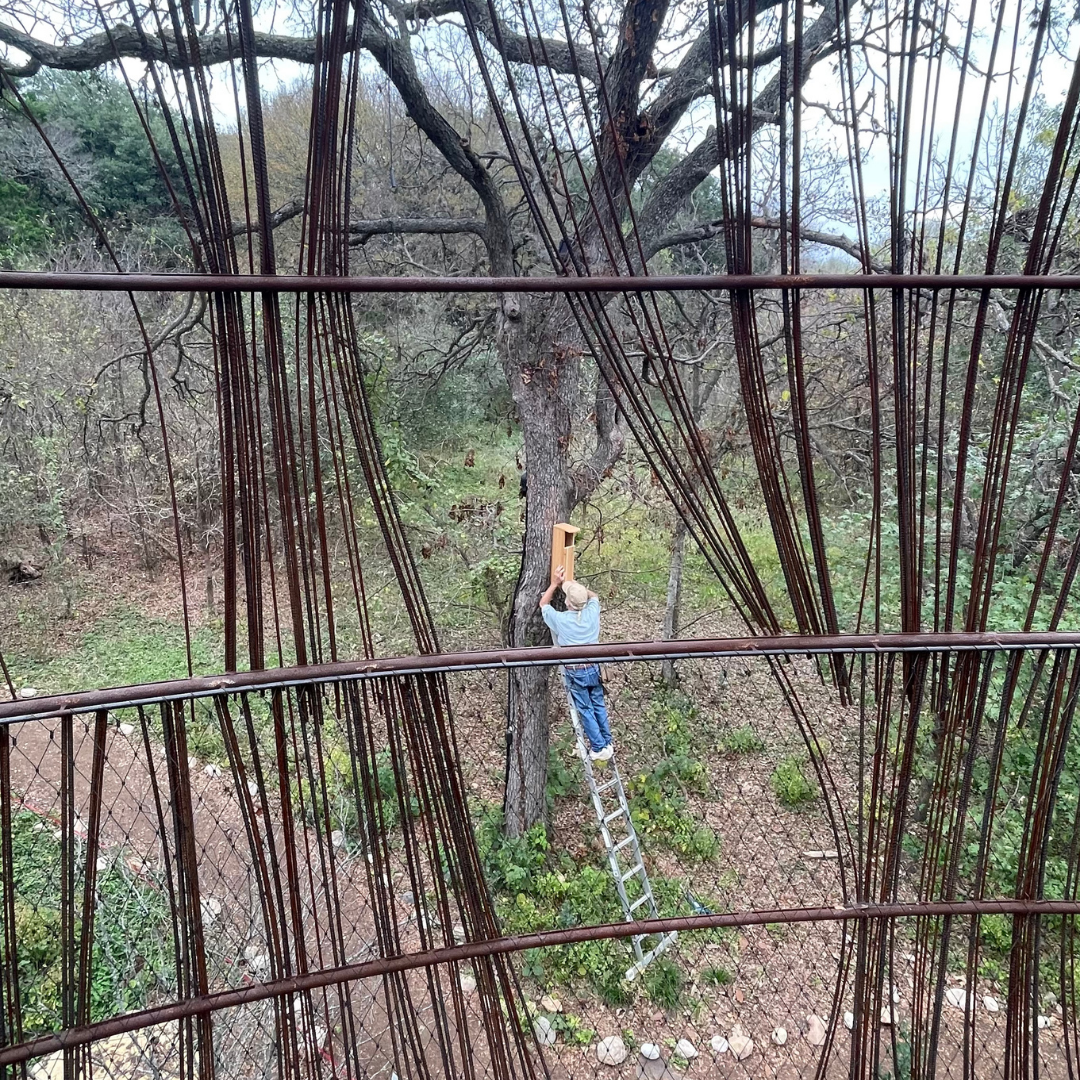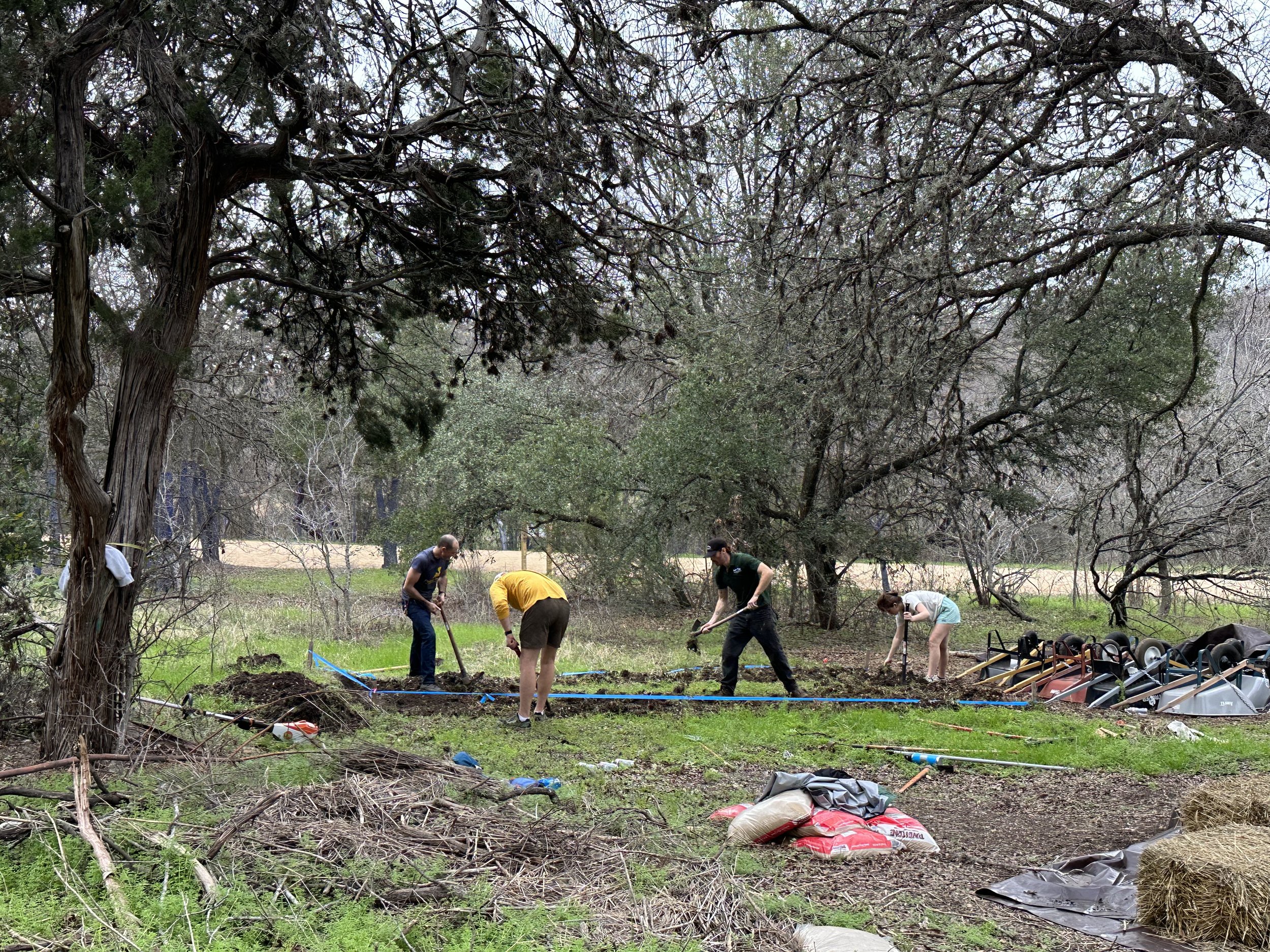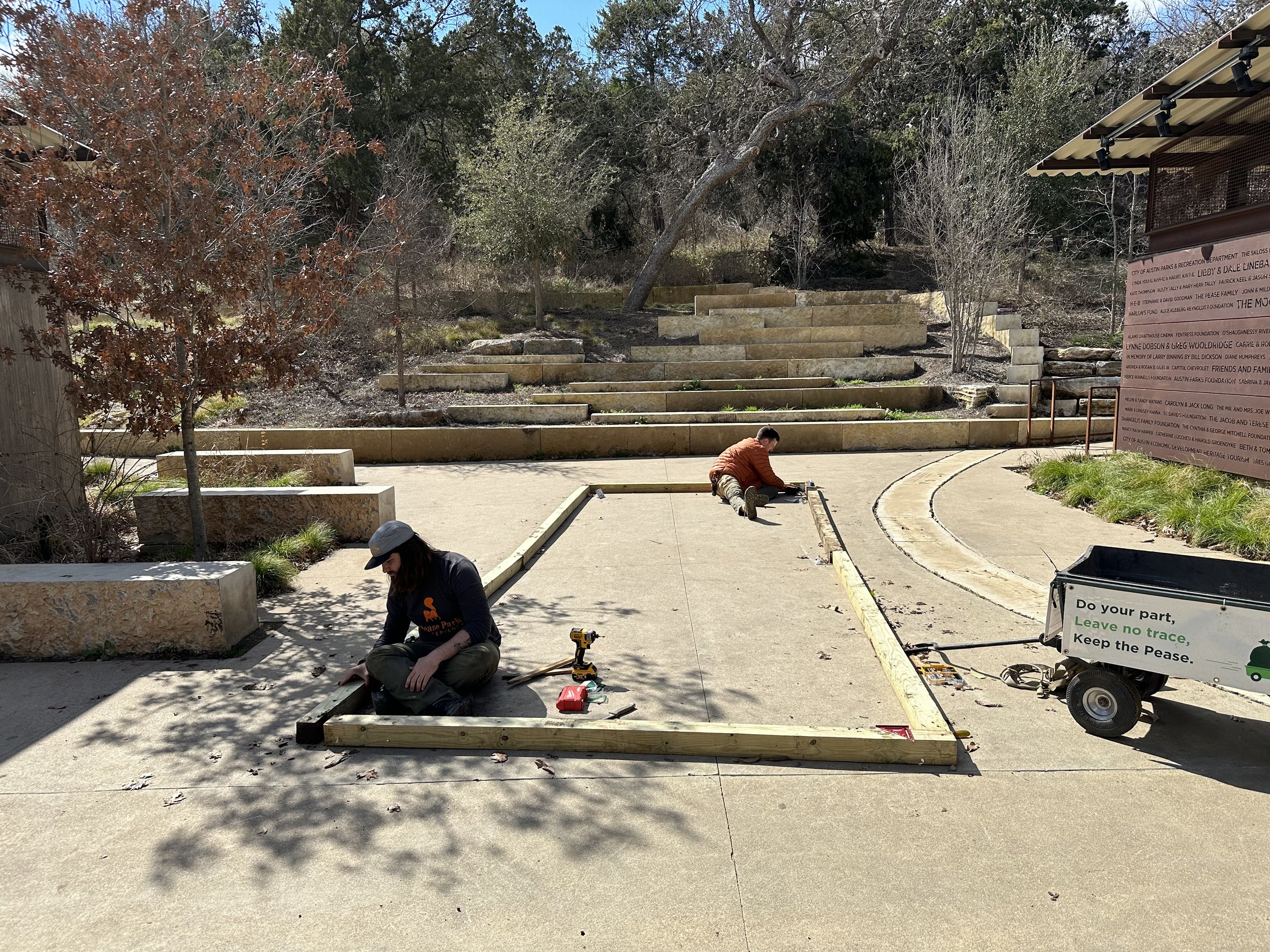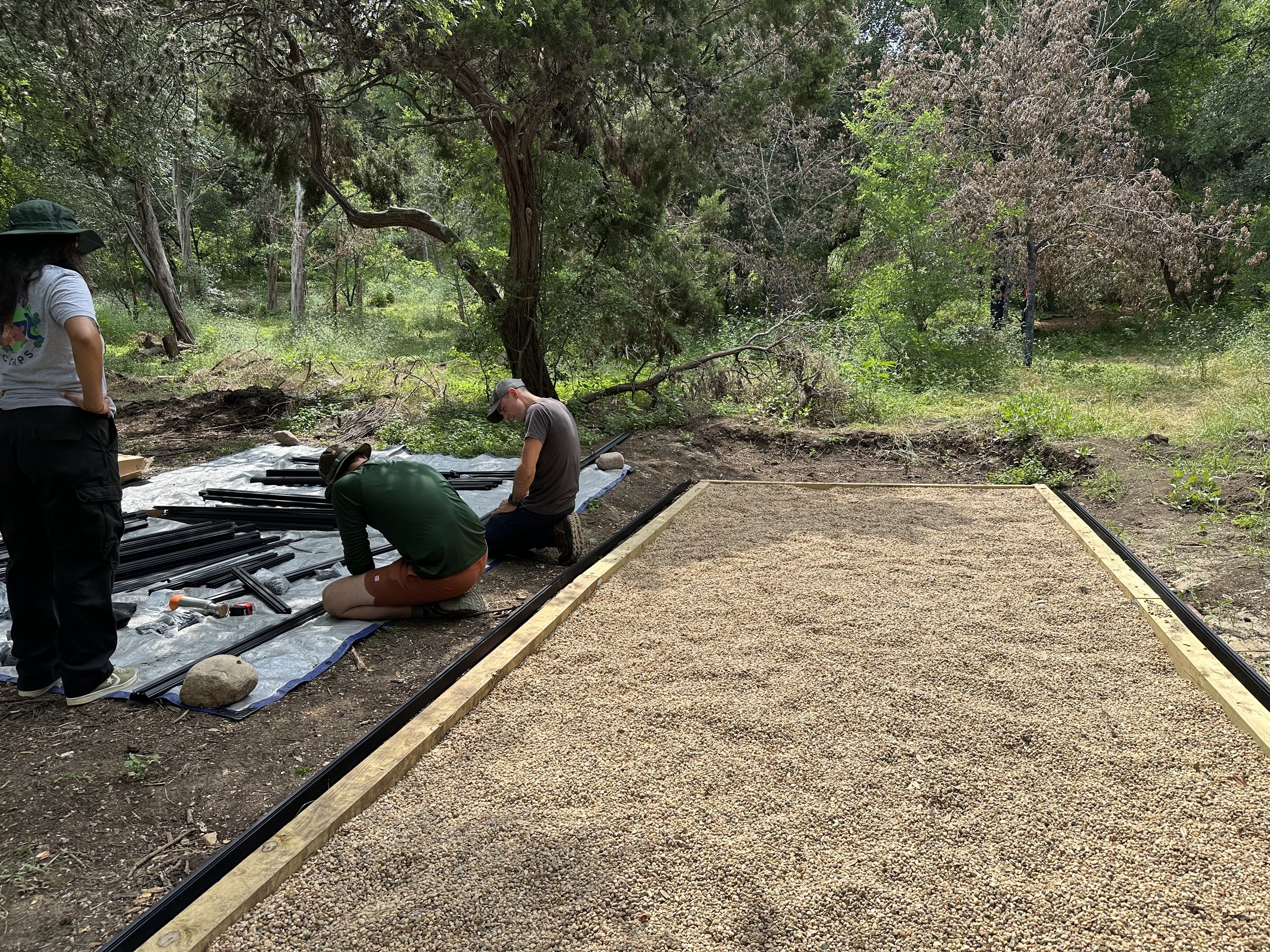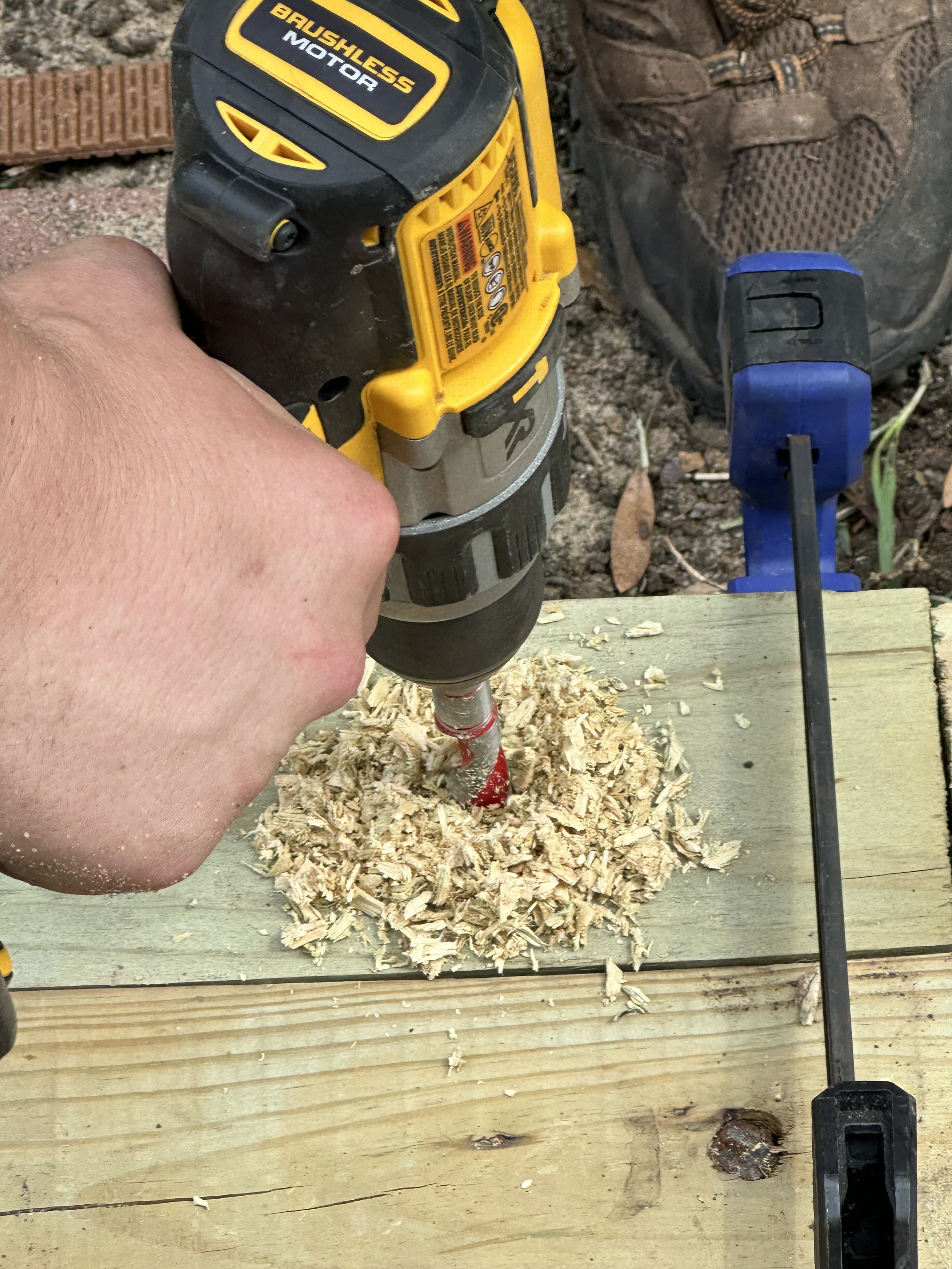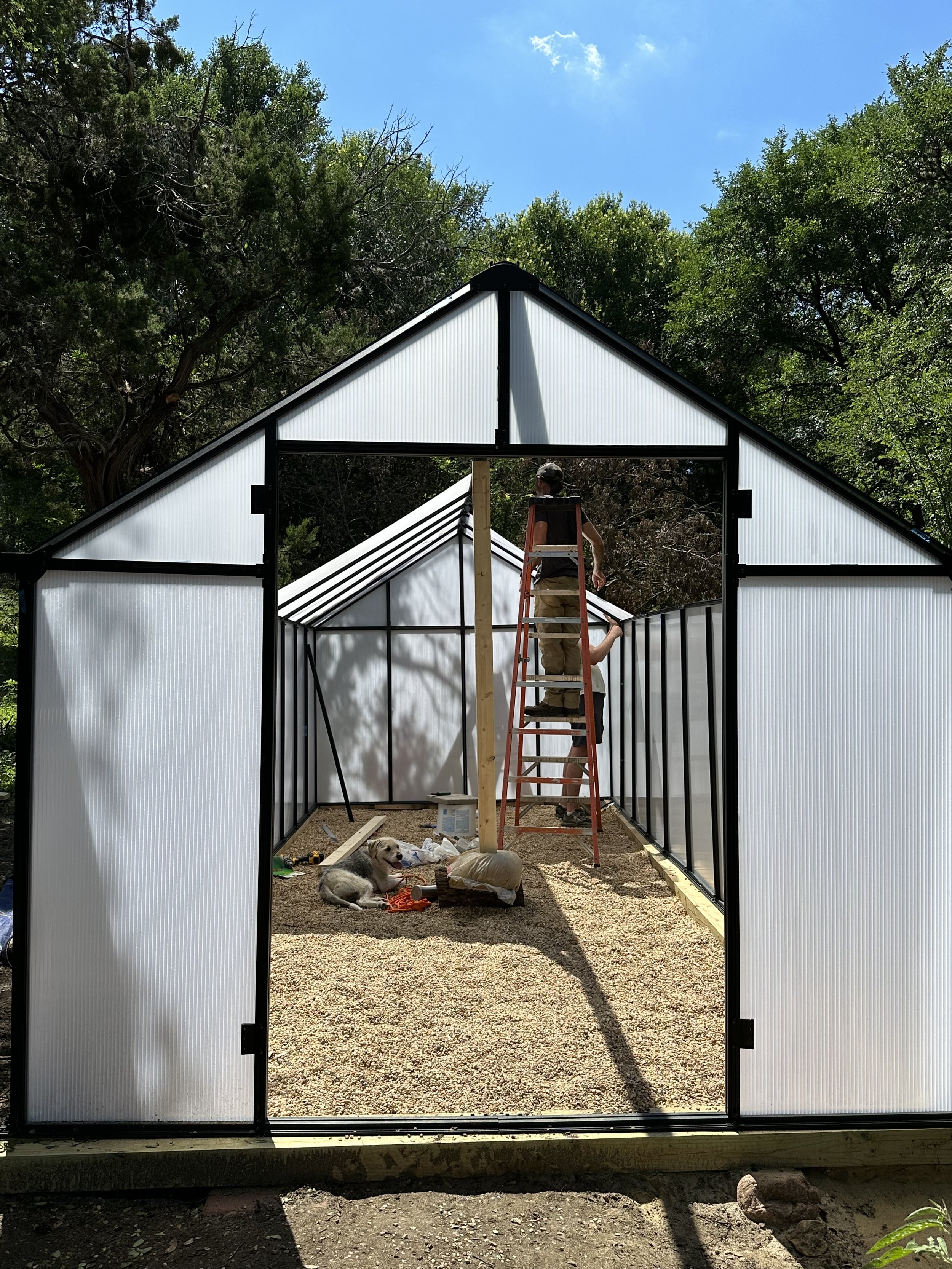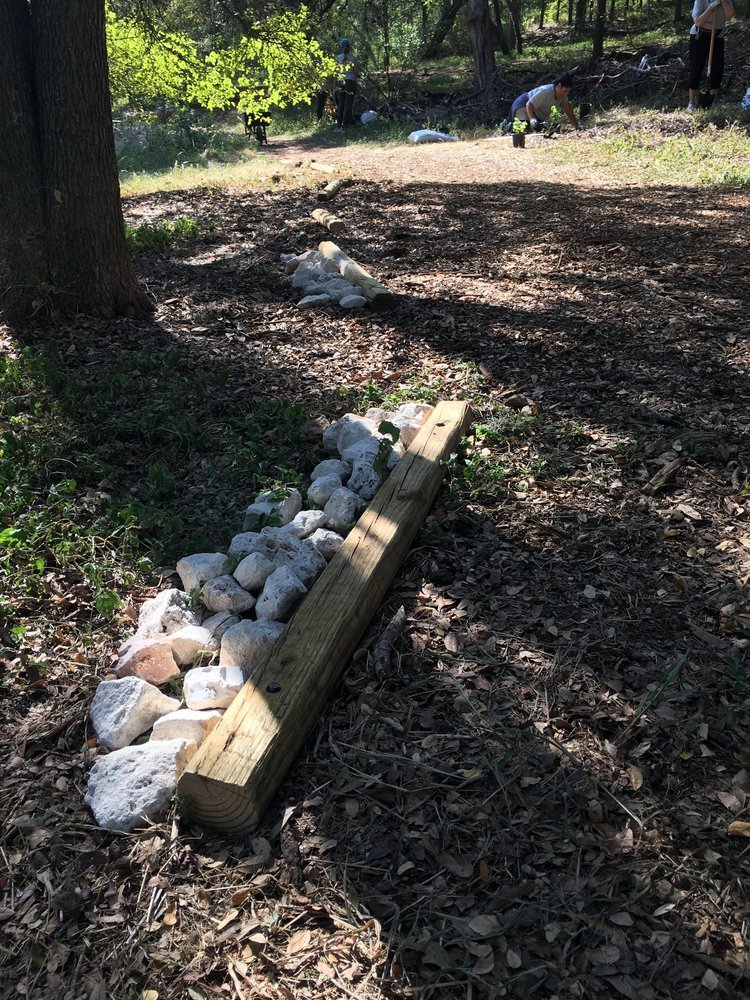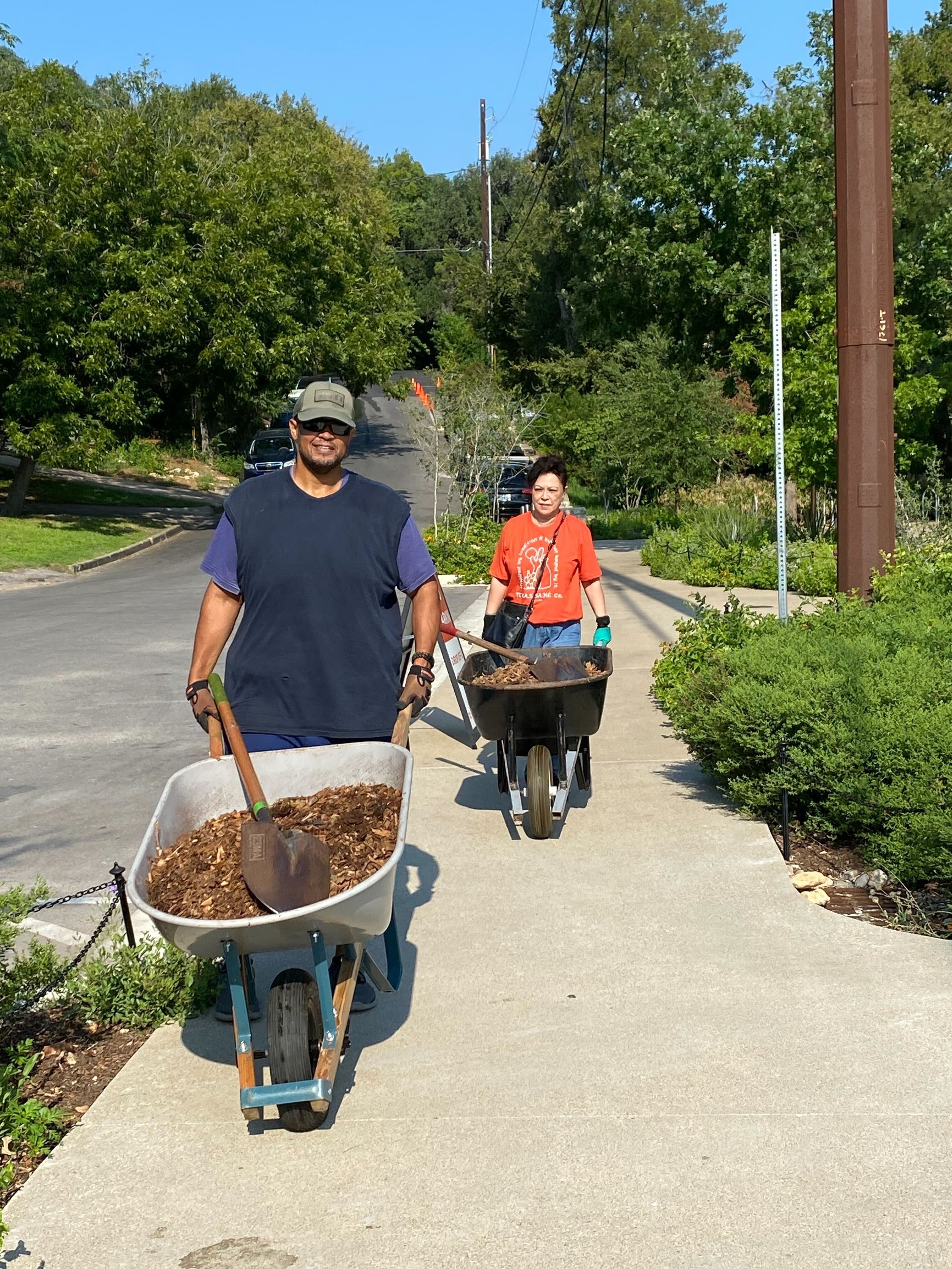Current Conservation Projects in Pease Park
The Windsor Hillside
The Windsor Hillside is located above Kingsbury Commons, on the western bank of Parkway.
More than 80% of this steep hillside was overrun by invasive Ligustrum, Chinaberry, and Catclaw - three species that outcompete the native plants of the Central Texas ecosystem. Native species provide necessary ecosystem services, such as sustenance and shelter for organisms in a habitat. The invasive species do not produce beneficial environmental services, thus negatively impacting the health of an ecosystem.
To correct this issue, Pease Park Conservancy’s Conservation team has taken the challenge of restoring the 226,593 square-foot site into native habitat. This feat includes a 5-year multi-phased plan to (a) remove invasive species, (b) replace them with native species, and (c) further manage and care for the area to ensure the survival of the re-introduced plants. The first phase of work focuses on an initial 65,000 square feet of hillside, while Phase 2 outlines the care of the remaining 161,593 square feet.
After a site study and the development of a detailed project management plan, PPC’s Conservation Team contracted with the Texas Conservation Corps to remove existing invasive plants in October of 2023. In addition to removing swaths of these plants, teams were able to remove 176 pounds of Chinaberry berries that could have produced thousands of saplings if given the chance to grow.
When restoring habitat, it is critical to immediately replant a site after removal has taken place, as the exposed ground serves as an open invitation for invasive species to encroach.
With a blank slate, the Conservation Team mobilized their expertise and resources to replant the site with beneficial species. Our dedicated community of volunteers came together on It’s My Park Day and the Pease Park Planting Day with Livelihood to introduce nearly 200 understory trees and plants to the Windsor Hillside. All of these plants were acquired through grants from the Austin Parks Foundation’s It’s My Park Day initiative, Livelihood Projects, and the APACHE Corporation Tree Grant Program, and include species such as:
Button Bush (Cephalanthus occidentalis L.)
Cedar Sage (Salvia roemeriana)
Coral Berry (Symphoricarpos orbiculatus)
Fragrant Mimosa (Mimosa borealis)
Mountain pea (Orbexilum pedunculatum)
Pigeonberry (Rivina humilis)
Possumhaw (Ilex decidua)
Roughleaf Dogwood (Cornus drummondii)
Turks Cap (Malvaviscus drummondii)
Yaupon holly (Ilex vomitoria)
White Mistflower (Ageratina havanensis)
With the removal and replanting steps completed, continued management is underway. Over the next five years, PPC’s Conservation team will water developing plants, monitor invasive encroachment, and offer the best care to these plants to ensure they survive and thrive.
Phase 2 of the Windsor Hillside project will come in future years once it is determined that the Phase 1 site has been successful.
The 24th Street Bridge
Bamboo is a fast and aggressive growing species that spreads through networks of underground root tubers, capable of producing new stalks.
Due to its dense and quick growth, bamboo has been a popular plant for creating privacy buffers between homes.
Unfortunately, bamboo has become a nuisance to surrounding habitats. Due to its aggressive growth, bamboo expands beyond garden beds and backyards, creeping into ecosystems where it can grow relatively unchecked. The north side of the 24th Street Bridge, in Wooten Woods, was one of these sites. After years of uncontrolled growth, it became an area fully clad in a thicket of bamboo.
To encourage native biodiversity and ecosystem services, Pease Park Conservancy embarked on a year-long venture to remove the invasive bamboo in this area and replant the site with native pollinator species.
This process began with the treatment of the existing bamboo by Bartlet Tree Experts in November of 2023. Bamboo stalks were cut and professionally coated with treatment to stunt growth. From there, the excavation of tubers by staff and groups of volunteers began in January of 2023 and lasted through May of 2023.
When managing an aggressively growing invasive species, it is crucial to be equally aggressive. Upon completion of the excavation, the bare ground was exposed to the harsh and hot summer sun to stress any remaining invasive species. After months of careful monitoring for new growth, Pease Park Conservancy began reestablishing the site as a native habitat.
As with any undertaking, a sound foundation is necessary for the success of a project. In the case of this project site, healthy soil was needed. Healthy soil promotes growth and facilitates the flow of nutrients, water, and air.
In early August of 2023, a layer of sheet mulch (cardboard) and an additional root barrier were installed on the site to prevent new growth. Afterward, our 2023 Richard Craig Volunteer Group of the Year (The Gables Residential) aided the soil amendment process by providing and applying layers of rich topsoil and double-ground mulch.
Next, the planting phase of the project began, and on November 5th, 2023, a mighty group of volunteers joined our official Roots & Wings Festival event - the Pease Park Planting Party. Participants learned proper planting procedures and introduced a total of 13 native and adapted plants to the hillside, including:
Coralberry (Symphoricarpos orbiculatus)
Yaoupon Holly (Ilex vomitoria)
Mountain Laurel (Dermatophyllum secundiflorum)
Texas Sage (Leucophyllum frutescens)
Mexican Bird of Paradise (Caesapinia pulcherrima)
Blanco Crabapple (Malus ioensis var. texana)
We are always looking for ways to bolster the native ecosystem and continue to welcome native species to Pease Park. In the case of the 24th Street site, we were able to introduce two Blanco Crabapple trees, a species endemic to our area, but at risk of being endangered.
Volunteers also spread several pounds of shade-friendly and horned-lizard habitat seed mixes and mulch.
Continued care of this site by staff and volunteers over the next several years will occur with continuous watering efforts, bamboo regrowth monitoring, mulching, planting, and seeding efforts when necessary.
Pease Park Owl Boxes
Pease Park Conservancy strives to be a habitat for Central Texas species amidst a bustling urban center. These 84 acres abound with native plants, mammals, birds, reptiles, amphibians, insects, and more.
The Eastern Screech Owl (Megascops asio) lives in this area and is identifiable by its big yellow eyes, raised ear tufts, and grayish-brown feathers. It predominantly feeds on large insects, small birds, lizards, and mice, but occasionally has been known to eat crayfish and bats.
Though found throughout much of the United States, Eastern Screech Owls have a challenging time finding suitable shelter. Owls naturally inhabit tree hollows, however, those are infrequent to come by in our area.
To combat this problem, Pease Park Conservancy partnered with Marshall May to install 30 owl boxes throughout Kingsbury Commons and Live Oak Meadow. Since 2006, Marshall has installed nearly 450 owl houses throughout the city that are expected to last over 30 years and are complete with drainage and natural ventilation properties. These cedar abodes are peppered throughout Pease Park and are homes of families of Eastern Screech Owls.
Lamar Terrace Wildflower Meadow
At Lamar Terrace, the Pease Park Conservancy team has designated an open field as a wildflower meadow.
We seek to make this site a biodiverse edge habitat that showcases the intrinsic beauty of our Central Texas prairies, while serving as an essential source of food and shelter for organisms that call Pease Park home. Over the years the Lamar Terrace Wildflower Meadow has bloomed less and less so our goal is to reintroduce and nurture an ocean of wildflowers to this area.
In the spring of 2023, the areas bordering the meadow were fenced off to designate “Grow Zones”. As defined by the City of Austin, “Grow Zones” are areas adjacent to bodies of water excluded from mowing efforts, thus allowing native flowers and grasses to grow wild and thrive. These zones are often located near stream banks to serve as a natural buffer that: helps slow the flow of runoff water into creeks; reduces weathering and erosion; breaks up compacted soil and promotes water infiltration when it rains; and even filters pollutants before they have a chance to enter the watershed.
Our Conservation Team ran a small experiment. To see which method would yield a more abundant meadow, one section of the meadow had its soil lightly broken up while the other remained undisturbed. Once the soil was prepared, the team used a native seed mix comprised of over 25 species of native wildflowers and grasses.
In preparation for the 2024 spring growing season, we tested various methods to produce a thriving wildflower meadow. Pease Park Conservancy’s Conservation team established five different 100-square-foot test plots at the site. Four of these plots have experienced light disturbance to allow adequate air and moisture to enter the soil and promote seed germination. Additionally, these same four plots received a distinctive type of substrate to see which supports the most growth. The fifth plot, or the control variable, received no additional substrate and was left undisturbed.
Plot 1: Disturbed ground with mulch
Plot 2: Disturbed ground with compost
Plot 3: Disturbed ground with mycorrhiza
Plot 4: Disturbed ground with no supplemental ground cover
Plot 5: Control: Undisturbed ground cover with no additional substrate. Staff threw wildflower seeds on top of existing grass to see how the seeds would fare.
With ongoing changes in climate conditions, this site serves as an experimental zone to test and adapt growing practices to yield the most bountiful wildflower meadow. In the next few months, these plots will further inform us of the best wildflower cultivation methods.
Greenhouse
Pease Park Conservancy’s free-standing greenhouse is a feature that allows us to cultivate our own plants.
The structure was completed in May of 2023 and is a working location for our team to grow seeds, conduct soil testing, store developing plants, and teach the next generation of environmental leaders!
Greenhouses function with the same principle that regulates the temperature of planet Earth. Simply put, the greenhouse effect on our planet begins with solar insolation (light energy from the sun) entering the atmosphere from space. Energy travels to Earth’s surface where it can either be absorbed by the surface or reflected back to the atmosphere and space. What is absorbed by surfaces like the ground, trees, open water, concrete, etc. is released as heat energy back into the atmosphere.
Similarly, the transparent property of the siding on a greenhouse allows solar energy (light) to enter the structure. Once inside, the light energy is absorbed by the plants, water, soil, and additional matter housed within the structure. As the day passes, that energy is slowly released in the form of heat energy, which bounces around the walls of the structure, keeping the space warm.
It took the Conservancy much time and dedication to build the greenhouse structure, but we look forward to using it for the benefit of the park and the community. Since its completion, we have already been able to introduce new native species to our garden beds and showcase the greenhouse as an interactive classroom during our Peasecology School Field Trips.
Waterbars
Pease Park’s proximity to Austin’s urban center means it is a getaway from the hustle and bustle of downtown for outdoor recreation. As an urban greenspace, we emphasize the use of designated trails for walking, hiking, and leisure. Treading on marked paths is not just a way to ensure safety, but doing so helps preserve the integral understory plants developing underneath the forest canopy.
To ensure these paths are safe, clearly designated, and suitable for use, we work to preserve their integrity and minimize the effects of weathering and erosion. On the Kingsbury Hillside in particular, trails are located on a hillside that is part of the greater Shoal Creek Watershed. With varying slopes and weather conditions, these trails are at risk of extensive weathering and erosion.
On your walk along the trail, you may notice unique wooden structures resembling Lincoln Logs. These curious little barriers are called waterbars and are a form of stormwater management that helps slow and redirect stormwater. Through staff and volunteer efforts, we have installed nearly 50 water bars to reduce the effects of erosion while helping to keep the trails stable and walkable.
These waterbars were installed by a group of Gables Residential volunteers as a part of their annual volunteer day with us, as well as community members who celebrated National Trails Day with us.
Ongoing Volunteer Initiatives
Many of our conservation projects depend on community involvement through our Pease Corps Volunteer Program.
Through these recurring volunteer opportunities, we are able to accomplish a vast array of projects, but equally as important, we are able to teach Austinites stewardship practices, build community, and contribute to a greater cause that connects us all.
Volunteers of varying backgrounds and ages can participate in activities like mulching, weeding, planting, seed collecting, invasive removal, watering, litter pick-up, event support, and much more!
Opportunities are published monthly and we are always eager to grow together. Click below to register for an upcoming volunteer opportunity!

















